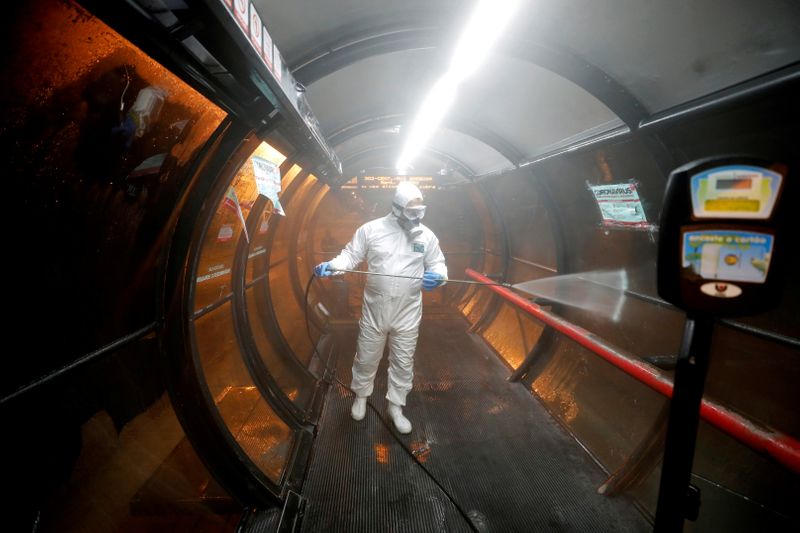
BRASILIA (Reuters) – Brazil appears set to embark cautiously on unconventional monetary policy using small interventions to tackle dysfunction in bond markets, as it does with foreign exchange, but the severity of the crisis may ultimately force it to emulate the dramatic steps taken in the United States and Europe.
Congress is debating a bill to grant the central bank emergency powers to carry out “quantitative easing” or QE as part of its crisis-fighting arsenal, allowing it to buy public and private financial assets during national emergencies.
With tax revenue plunging and expenditure soaring to mitigate the pandemic’s economic fallout, Brazil’s right-wing government expects its deficit will explode this year to 600 billion reais ($115 billion), or 8% of gross domestic product.
While the Federal Reserve and European Central Bank are firing their “bazookas”, asset purchase programs worth trillions of dollars and euros, sources say Brazil’s QE will be much more limited in scope and targeted in nature.
Central Bank Chief Roberto Campos Neto has said that his preferred version of QE would flatten the yield curve without expanding the monetary base or the bank’s balance sheet, by buying long-dated bonds while selling short-dated debt – akin to the Fed’s “Operation Twist” in 2011.
Traders say parts of the debt market ceased to function normally during the recent bout of risk aversion. The spread between January 2021 and January 2029 rates futures widened to more than 600 basis points in March, and although it has since come back, is still significantly wider than it was in February.
Graphic – Brazil interest rate futures: https://fingfx.thomsonreuters.com/gfx/mkt/dgkvlerzpbx/RATESPREAD.png
However, a source familiar with central bank thinking and two former central bank presidents said that the bank may opt for a cautious approach initially, intervening only to smooth out market distortions as it does in FX.
The source said it is not the central bank’s explicit goal to flatten the yield curve, nor its job to stop the market from pricing in fiscal risk as the deficit widens by demanding higher yields.
Former central bank president Arminio Fraga said that, while foreign central banks are using QE as a massive economic stimulus to bring down long-term interest rates and boost asset prices, Brazil’s approach would be more “defensive”.
“Here, QE would be more like FX intervention. If there is any panic in the bond market the central bank could intervene in the secondary market to relieve the pressure,” Fraga told Reuters, adding that the bank’s personnel are “responsible and sensible”.
The central bank said it does not comment on bills going through the legislative process.
DEPRESSION DANGER
But some economists say such caution underestimates the scale of the coming crash. The International Monetary Fund last week slashed its 2020 forecast for Brazil’s economy to a 5.3% contraction from a previous estimate of 2.2% growth.
It also warned that Latin America faced a lost decade of growth because of the pandemic.
Willem Buiter, visiting professor at Columbia University in New York and former Bank of England policymaker, said policy makers must abandon concerns about the exchange rate, inflation and deficits, or deep recession could turn into a depression.
“The situation is dire. It requires the central bank to use its full expansionary toolkit to support the fiscal stimulus that the government is providing,” Buiter said.
“They (central bankers) should just let go and buy both short- and long-term bonds … and be ready to cover the government deficit this year,” he said.
Brazil’s constitution currently only allows the central bank to buy government bonds on the secondary market for interest rate or money supply management purposes, but forbids it from funding the government.
The central bank’s balance sheet is already large, at 56% of GDP last month. Foreign exchange reserves account for around 40% of that and government bonds just over 50%.
Some market participants and former officials worry that printing money and increasing the central bank’s balance sheet would leave the banking system awash in excess liquidity. This could push the effective overnight interbank rate towards zero, well below the actual benchmark rate of 3.75% and creating distortions in the money markets.
“This would have hugely negative consequences for Brazil. It would devalue the currency in a sharp way and ultimately steepen the yield curve,” said Sergio Goldenstein, former head of open market operations at Brazil’s central bank, warning of the risk of capital flight.
He supported Campos Netos’ idea of bringing down longer-term yields without expanding the monetary base. He says the central bank could “sterilize” purchases of long-term bonds with reverse repurchase agreements for shorter-term Treasury bills of six or nine months maturity.
Former central bank president and finance minister Henrique Meirelles also said that the central bank could aim at first simply to smooth out any bond market stresses and volatility, providing liquidity without targeting a certain price level.
“The central bank’s bond market intervention could be like its FX market intervention,” Meirelles told Reuters.
But he noted that, like ECB president Mario Draghi in the depth of the euro crisis, Campos Neto must be ready to do “whatever it takes”.
“The central bank must do whatever it takes to fight this crisis, support the economy, provide liquidity to financial markets and make sure they function smoothly. It should use whatever tools it has at its disposal and act in whatever size necessary to achieve these ends,” he said.



